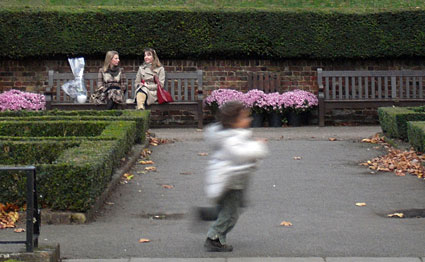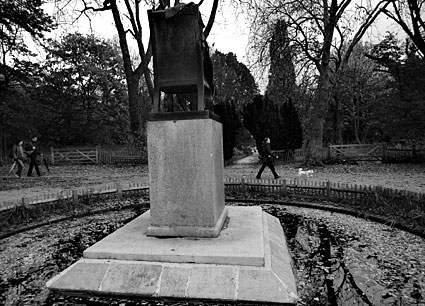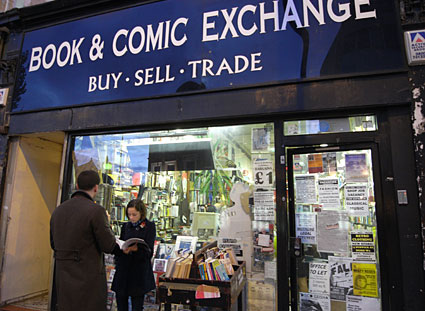|
Around Holland Park and into Notting Hill
Part two of a late Autumn city walk in west London. (Part 1 - Part 2)
(Photos/words © urban75, 10th November, 2007)
Developed around the grounds of the Jacobean mansion, Holland House, Holland Park is one of London's smallest public parks and features semi-wild woodland, formal gardens, an Orangery, a children's playground and sports facilities.
It's also the home of the open air Holland Park Theatre.

Slightly less than welcoming sign.

The famous Orangery, which hosts a gallery and a cafe. I stopped off here for tea and scones and checked the football scores on my Palm Treo phone.
Sadly, the mighty Cardiff City FC were losing again.

Opened as public park as late as 1952, Holland Park takes its name from Sir Henry, earl of Holland who was formerly resident at Holland House.
Here you can see the geometric Formal Gardens, created in 1812 by Buonaiuti.
Originally known as the 'Portuguese garden,' it was renamed after Britain fell out with Portugal.


Holland House was bombed during the Second World War and suffered major damage with just the ground floor surviving.
The restored East Wing currently houses a youth hostel, with the Belvedere restaurant occupying the former summer ball room.
Holland House was occupied by Cromwell's army during the English civil war.



The Iris Garden Fountain, designed by William Pye. At dusk there's apparently some laser beam decorations to be seen.


Another view of the remaining parts of Holland House, built in 1606.

The inscription reads, "Earth would be less fair without trees to grace her valleys, hide her scars, cast cool shade, in gardens here."



The curious 'Walking Man' sculpture in Holland Park by Dhruva Mistry.

The Kyoto Japanese Garden was built for the 1991 London Festival of Japan.

A co-operative project between the Royal Borough of Kensington and Chelsea and Kyoto Chamber of Trade in Japan, the Kyoto garden is styled on a Japanese garden.





Lord Holland's Pond, set within 54 acres of Holland Park.

Statue of a seated Lord Holland in Holland Park by the English painter, sculptor and radical socialist, George Frederic Watts (1817-1904).
Watts was the inspiration behind Postman's Park near St Bartholomew's Hospital.

There's something rather sad about this lone figure stuck in the middle of the park.


A lone walker heads out of the park as dusk falls.

Entrance gate.

Ladbroke Walk mews.

A long row of solid houses dating from the 1840s along Ladbroke Square, facing Ladbroke Square Gardens.

The sun sets on Ladbroke Square.


Pembridge Road, Notting Hill.

The 12th House restaurant at 35 Pembridge Road is (ahem) 'astrology-themed' with guests asked what their star sign is and then being presented with a horoscope.
If hanging out with metaphysical types is your kind of thing, it's a must-visit!

Book and Comic Exchange at 14 Pembridge Road.

Tube station. Back to Brixton!

|

